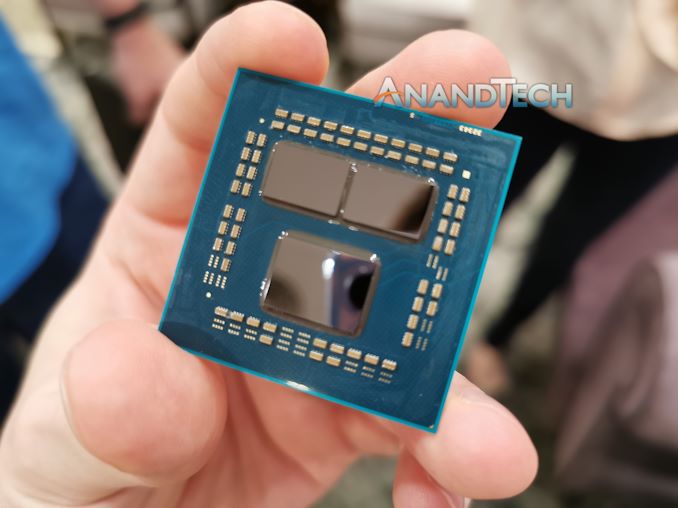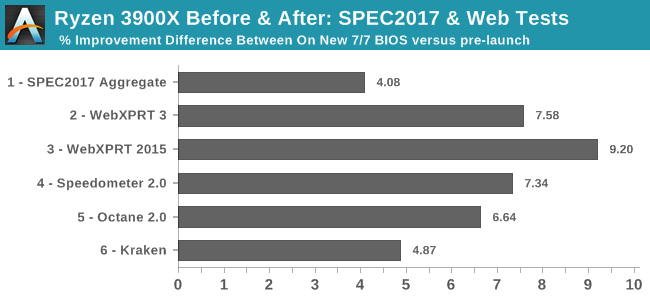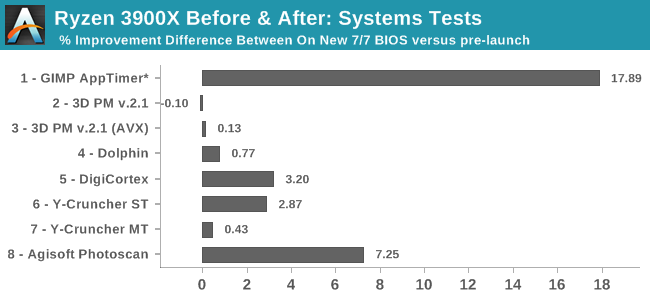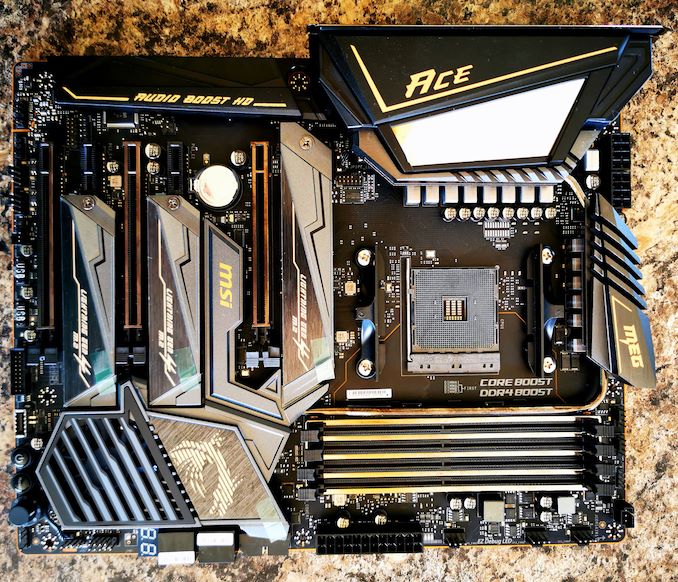AMD Ryzen 3000 Post-Review BIOS Update Recap: Larger ST Gains, Some Gains, Some Losses
by Andrei Frumusanu on July 11, 2019 2:00 PM EST- Posted in
- CPUs
- Gaming
- AMD
- Zen 2
- Ryzen 3000
- Ryzen 3900X

It’s been a long two weeks following our AMD-review-athon weekend, culminating 7/7 with our extensive coverage of the new Ryzen 3000 series CPUs, the new Radeon RX 5700 series Navi GPUs, as well as our complete overview of X570 chipset based motherboards.
Among the things that didn’t go quite as planned for in the hectic period leading up to Sunday was the matter of launch BIOSes. Always a thorny issue with new platform launches – BIOSes are often under intensive development right up until a new platform ships – we ended up in a situation where some boards had multiple BIOS versions floating around, with performance differences among them. And, while Moore's Law may be dead, Murphy's Law is alive and well, so of course the BIOS we ended up doing our initial Ryzen 3000 testing on was not the best BIOS for the platform.
So, we want to clarify the timeline of events for how we initially tested, what we’ve re-tested, and if and how the new BIOS behavior might change our original conclusion of the Ryzen 3000 series.
To go a little bit behind the scenes and talk about AMD's sampling process, the company had initially focused on outfitting reviewers with a selection of 4 different X570 motherboards. Among them was MSI's flagship, the MSI MEG X570 Godlike, which along with the MSI MEG X570 Ace, we already had in the lab for use in our first round of motherboard reviews. In a stroke of bad luck, our Godlike didn't make it to us intact, and we were never able get it to boot. So, following a further comedy of logistics issues that end with us receiving the CPUs only a few days before the launch date – and thus, without enough time to get a replacement board – we turned to our other X570 board, MSI's MEG Ace.
The MSI X570 MEG Ace, in turn, is still one of MSI's high-end motherboards and would normally be a good choice for a review board. The pitfall of using the Ace in this situation, however, is it wasn't one of the launch boards AMD was working with. So it didn't have an explicit and finely-tuned review BIOS like the Godlike had.
Ultimately, due to time pressure as well as unfamiliarity with the new Ryzen 3000 boosting behavior, we didn’t quite catch any issues of the board’s BIOS (or had been forewarned of issues) until we learned about and A/B tested a new public BIOS by MSI following the review article.
In a custom frequency test, we were able to verify that AMD’s new UEFI CPPC2 interface (Collaborative Power and Performance Control) wasn’t correctly working on the board as it did not boost to the higher frequencies, but most importantly it didn’t ramp up frequencies in the 1-2ms periods that AMD had promised, but rather in a quite slow ~500ms.
Re-testing and Updating Our Numbers
We’ve since been able to re-test both the Ryzen 9 3900X as well as the Ryzen 7 3700X, and have accordingly updated the review article with the new numbers. Furthermore, for everyone who has already read the initial review, we wanted to post a summary of the changes in the different workloads we saw on the 3900X:

The biggest change was in tests that are bound by the performance of a single thread. These tests primarily have either multiple threads with just a single heavy thread, or just one thread period. Here we saw the effect of the new BIOS in action, allowing the CPUs to get nearer to their advertised maximum boost speeds, and we saw the biggest increases ranging from 4% in SPEC to 7-9% in the web tests.
Interactive tests such as WebXPRT particularly saw bigger changes as the frequency boosts was amplified by the faster frequency ramp-up speed, resulting in increases that were above the 5.8% higher boost frequencies we were able to verify.

*Note: The 3900X AppTimer result is likely an outlier.


In the systems, rendering, and encoding tests, the performance changes and improvements strongly depended on the workload’s multi-threaded behavior. Agisoft’s Photoscan test behaves similarly to the web tests in terms of improvements, while heavy multi-threaded tests in the system suite didn’t see any changes. Some tests have single-threaded component bottlenecks in them which end up with improvements in-between, averaging around 2-3%.

Gaming benchmark changes was a bit more varied in terms of results, particularly because we saw some larger degradations. The main reason here is that some titles while being multi-threaded, have only a limited number of threads. In these titles and situations where we’re not just purely bound by performance of a single large thread, it’s likely that we’re seeing the CPU clock slightly lower in the new release BIOS compared to what we tested originally. Our results were also consistent across multiple runs in this regard, so this isn't an artifact of normal run-to-run variation.
Overall Conclusion: Better Single-Threaded Results, But Same Positioning
Overall MSI's updated launch BIOS improved our original numbers the most in areas where the new Ryzen 3000 already excelled at: office and productivity applications. Particularly exclusive single-threaded workloads saw a larger boost which makes the new Zen 2 all the more impressive. Meanwhile the toss-up in the gaming results seems to point out that there’s still improvements to be made in AMD’s boosting algorithms. None of this changes our overall performance analysis or recommendations, but when the difference between Intel and AMD is sometimes a game of inches, it's unsurprising that everyone is greatly interested in even the smallest change.
AMD did note that results might vary from vendor BIOS to vendor BIOS. In this regard, we’ll be continuing to monitor BIOS changes over the next few weeks and see if there will be any more substantial behavior updates in the new Precision Boost 2 mechanism.
What is for sure though, is that if you’re aiming to buy a new Ryzen 3000 series CPU, make sure to keep yourself updated on the newest BIOS as it’s likely the versions shipping with new X570 boards will not fully represent the full performance the new CPUs are capable of.












75 Comments
View All Comments
Meteor2 - Monday, July 15, 2019 - link
Without wanting to sound a massive Debbie Downer, I'm going to repost a comment I just made on the original review article.It's hard to get one's head around this, but basically: *all* the Intel benchmarks *do not* include the security patches for the MDS-class flaws. The 9000 and 8000 series tests do include the OS-side Spectre fixes, but that's it. No OS-fixes for other CPUs, and no motherboard firmware fixes for any Intel CPUs
At the very least, all the Intel CPUs should be retested on Windows 10 1903 which has the OS-side MDS fixes.
Most if not all the motherboards used for the Intel reviews can also have their firmware upgraded to fix Spectre and most times MDS flaws. Do it.
This is sensible and reasonable to do: no sensible and reasonable user would leave their OS vulnerable. Maybe the motherboard, because it's a bit scary to do, but as that can be patched, it should be by reviewers.
This would result in all the Intel scores being lower. We don't know by how much without this process actually being done. But until it is, the Intel results are invalid.
RSAUser - Wednesday, July 17, 2019 - link
Most users wouldn't even have a choice, Windows would usually push chip-set updates via update center.nismotigerwvu - Thursday, July 11, 2019 - link
Just saw a minor typo,"We’ve since been able to re-test both the Ryzen 9 3900X as well as the Ryzen 7 3900X"
That should read "...the Ryzen 7 3700X" right?
Ryan Smith - Thursday, July 11, 2019 - link
Ah, yes. That's one more 3900X than we tested!JoeyJoJo123 - Thursday, July 11, 2019 - link
"REEEEEEE! BUT AMD IS LYING ABOUT SINGLE CORE TURBO SPEEDS! THIS DOESN'T FIX ANYTHING! IF INTEL DID THIS, IT'D BE A BIG DEAL, THANKS FOR BEING AN AMD SHILL, $N$NDTECH!"-- sincerely, an Intel shill internet warrior who does it FOR FREEEEEEE
Xyler94 - Friday, July 12, 2019 - link
I think my brain exploded from this, x3guachi - Thursday, July 11, 2019 - link
I appreciate the work in bringing us the update. There are lots of new Ryzen 7 CPUs but a complete chart (eventually) with every processor would be awesome! Lots of work but a great way to get clicks as you add more processors and the first site to have a complete set will surely net a lot of attention.guachi - Thursday, July 11, 2019 - link
Sigh... change "Ryzen 7" to "Zen 2" as I mean the entire new lineup of Zen 2 processors.binkleym - Thursday, July 11, 2019 - link
Given that several motherboards are having to remove features (RAID, graphical BIOS, user profiles) from the BIOS in order to fit the AGESA for Zen 2, it would be nice if motherboard reviews would start mentioning the size of the BIOS, so we can easily discern which motherboards are designed to be future-proof, and which ones are nickel'd and dime'd into early obsolescence.Irata - Friday, July 12, 2019 - link
AFAIK, this has been mitigated for X570 boards but I definitely agree with you that this would be an important point and good to know.